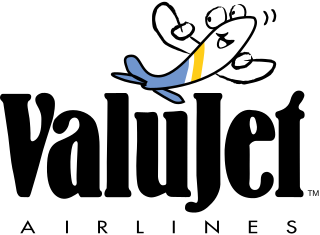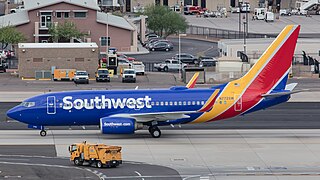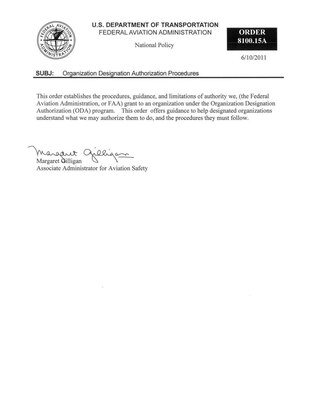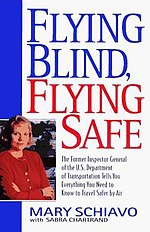
The Federal Aviation Administration (FAA) is a U.S. federal government agency within the U.S. Department of Transportation which regulates civil aviation in the United States and surrounding international waters. Its powers include air traffic control, certification of personnel and aircraft, setting standards for airports, and protection of U.S. assets during the launch or re-entry of commercial space vehicles. Powers over neighboring international waters were delegated to the FAA by authority of the International Civil Aviation Organization.

ValuJet Airlines was an ultra low-cost airline in the United States that operated from 1992 until 1997, when it was rebranded as AirTran Airlines after joining forces with AirTran Airways. It was headquartered in unincorporated Clayton County, Georgia, that operated regularly scheduled domestic and international flights in the Eastern United States and Canada during the 1990s. The company was founded in 1992 and was notorious for its sometimes dangerous cost-cutting measures. All of the airline's planes were purchased used from other airlines; very little training was provided to workers; and contractors were used for maintenance and other services. The company quickly developed a reputation for safety issues. In 1995, the military refused ValuJet's bid to fly military personnel over safety worries, and officials at the FAA wanted the airline to be grounded.
Mary Fackler Schiavo is the former Inspector General of the United States Department of Transportation (DOT), where for six years she withstood pressure from within DOT and the Federal Aviation Administration (FAA) as she sought to expose and correct problems she perceived at the agencies. In 1997, after her stormy tenure at the DOT, Schiavo wrote Flying Blind, Flying Safe, which summed up her numerous concerns about the FAA's systemic flaws.

The Air Line Pilots Association, International (ALPA) is the largest pilot union in the world, representing more than 77,000 pilots from 43 US and Canadian airlines. ALPA was founded on 27 July 1931 and is a member of the AFL-CIO and the Canadian Labour Congress. Known internationally as US-ALPA, ALPA is also a member of the IFALPA.

Marion Clifton Blakey is an American businesswoman and former government official who served as president and CEO of Rolls-Royce North America. Prior to joining Rolls-Royce, she served as the eighth full-time chief executive of the Aerospace Industries Association, an American defense industry trade association from 2007 to 2015. Before this, she served a five-year term as the 15th Administrator of the Federal Aviation Administration. Blakey was the second woman to hold the position, serving as a successor to Jane Garvey, the first woman to hold the Administrator title. She was the second Administrator who was not a licensed pilot. She was awarded the Wright Brothers Memorial Trophy in 2013.

Jane F. Garvey is a former government transportation and public works official, now an American business executive, currently serving as the chairman of Meridiam North America. She was the first female Administrator of the U.S. Federal Aviation Administration from 1997 to 2002. In May 2018, she was tapped to become the first female Chairman of United Continental Holdings.

James Horace Burnley IV is an American politician and lawyer. He served as the United States Secretary of Transportation from 1987 until 1989, during the administration of President Ronald Reagan. He is a partner at Venable LLP in Washington, D.C.

United Air Lines Flight 297 was a scheduled flight from Newark International Airport to Atlanta that crashed 10 miles (16 km) southwest of Baltimore on November 23, 1962, killing all 17 people on board. An investigation concluded that the aircraft, a Vickers Viscount 745D turboprop airliner, had struck at least two whistling swans, which caused severe damage to the plane, resulting in a loss of control.
Airlines for America (A4A), formerly known as Air Transport Association of America (ATA), is an American trade association and lobbying group based in Washington, D.C. that represents major North American airlines since 1936.

In aviation, the sterile flight deck rule or sterile cockpit rule is a procedural requirement that during critical phases of flight, only activities required for the safe operation of the aircraft may be carried out by the flight crew, and all non-essential activities in the cockpit are forbidden. In the United States, the Federal Aviation Administration (FAA) imposed the rule in 1981, after reviewing a series of accidents that were caused by flight crews who were distracted from their flying duties by engaging in non-essential conversations and activities during critical parts of the flight.
The Next Generation Air Transportation System (NextGen) is an ongoing United States Federal Aviation Administration (FAA) project to modernize the National Airspace System (NAS). The FAA began work on NextGen improvements in 2007 and plans to finish the final implementation segment by 2030. The goals of the modernization include using new technologies and procedures to increase the safety, efficiency, capacity, access, flexibility, predictability, and resilience of the NAS while reducing the environmental impact of aviation.
Taquan Air is the operating name for Venture Travel, LLC, an American regional airline headquartered in Ketchikan, a city in the southeastern portion of the U.S. state of Alaska. It operates domestic scheduled passenger and charter services. Its base is Ketchikan Harbor Seaplane Base, which shares the same harbor and airspace as Ketchikan International Airport. As per the United States Department of Transportation in a report dated August 2, 2010, Taquan Air is a "U.S. Certificated Air Carrier", and is 1 of 125 such carriers in the US.

Colgan Air Flight 3407 was a scheduled passenger flight from Newark, New Jersey, US to Buffalo, New York, US on February 12, 2009. Colgan Air staffed and maintained the aircraft used on the flight that was scheduled, marketed, and sold by Continental Airlines under its Continental Connection brand. The aircraft, a Bombardier Q400, entered an aerodynamic stall from which it did not recover and crashed into a house at 6038 Long Street in Clarence Center, New York at 10:17 pm EST, killing all 49 passengers and crew on board, as well as one person inside the house.
FlyersRights.org is a United States based not-for-profit organization that advocates for the rights and interests of airline passengers. It maintains a staffed office in Washington, D.C. for advocacy before all three branches of the US Federal Government. It operates a toll-free telephone Hotline, an email helpline for individual air travelers and a website with a 'Know Your Rights' online guide. It issues research and policy papers, conducts surveys, sponsors online petitions, maintains an active website and social media presence, provides expert advice on aviation consumer issues to public policy makers and opinion leaders and engages in public education activities.

The Aviation Innovation, Reform, and Reauthorization (AIRR) Act was a bill introduced on February 3, 2016, in the 114th Congress (2015-2016) by Congressman Bill Shuster (R-PA) and Frank LoBiondo (R-NJ). Among other things, the bill would have privatized the American air traffic control (ATC) system. The bill would also have reauthorized the Federal Aviation Administration (FAA) through 2019.

Southwest Airlines Flight 1380 was a Boeing 737-700 that experienced a contained engine failure in the left CFM International CFM56 engine after departing from New York–LaGuardia Airport en route to Dallas Love Field on April 17, 2018. The engine cowl was broken in the failure, and cowl fragments damaged the fuselage, shattering a cabin window and causing explosive depressurization of the aircraft. Other fragments caused damage to the wing. The crew carried out an emergency descent and diverted to Philadelphia International Airport. One passenger was partially ejected from the aircraft and sustained fatal injuries, while eight other passengers sustained minor injuries. The aircraft was substantially damaged.

The Boeing 737 MAX passenger airliner was grounded worldwide between March 2019 and December 2020 – longer in many jurisdictions – after 346 people died in two similar crashes in less than five months: Lion Air Flight 610 on October 29, 2018, and Ethiopian Airlines Flight 302 on March 10, 2019. The Federal Aviation Administration initially affirmed the MAX's continued airworthiness, claiming to have insufficient evidence of accident similarities. By March 13, the FAA followed behind 51 concerned regulators in deciding to ground the aircraft. All 387 aircraft delivered to airlines were grounded by March 18.

The Organization Designation Authorization (ODA) program was established by FAA Order 8100.15 . The ODA, in conjunction with the Federal Aviation Administration (FAA), grants airworthiness designee authority to organizations or companies. The regulations addressing the ODA program are found in Title 14 of the Code of Federal Regulations part 183, subpart D, sections 183.41 through 813.67.

The two fatal Boeing 737 MAX crashes in October 2018 and March 2019 which were similar in nature – both aircraft were newly delivered and crashed shortly after takeoff – and the subsequent groundings of the global 737 MAX fleet drew mixed reactions from multiple organizations. Boeing expressed its sympathy to the relatives of the Lion Air Flight 610 and Ethiopian Airlines Flight 302 crash victims, while simultaneously defending the aircraft against any faults and suggesting the pilots had insufficient training, until rebutted by evidence. After the 737 MAX fleet was globally grounded, starting in China with the Civil Aviation Administration of China the day after the second crash, Boeing provided several outdated return-to-service timelines, the earliest of which was "in the coming weeks" after the second crash. On October 11, 2019, David L. Calhoun replaced Dennis Muilenburg as chairman of Boeing, then succeeded Muilenburg's role as chief executive officer in January 2020.

The Boeing 737 MAX was initially certified in 2017 by the U.S. Federal Aviation Administration (FAA) and the European Union Aviation Safety Agency (EASA). Global regulators grounded the plane in 2019 following fatal crashes of Lion Air Flight 610 and Ethiopian Airlines Flight 302. Both crashes were linked to the Maneuvering Characteristics Augmentation System (MCAS), a new automatic flight control feature. Investigations into both crashes determined that Boeing and the FAA favored cost-saving solutions, which ultimately produced a flawed design of the MCAS instead. The FAA's Organization Designation Authorization program, allowing manufacturers to act on its behalf, was also questioned for weakening its oversight of Boeing.














